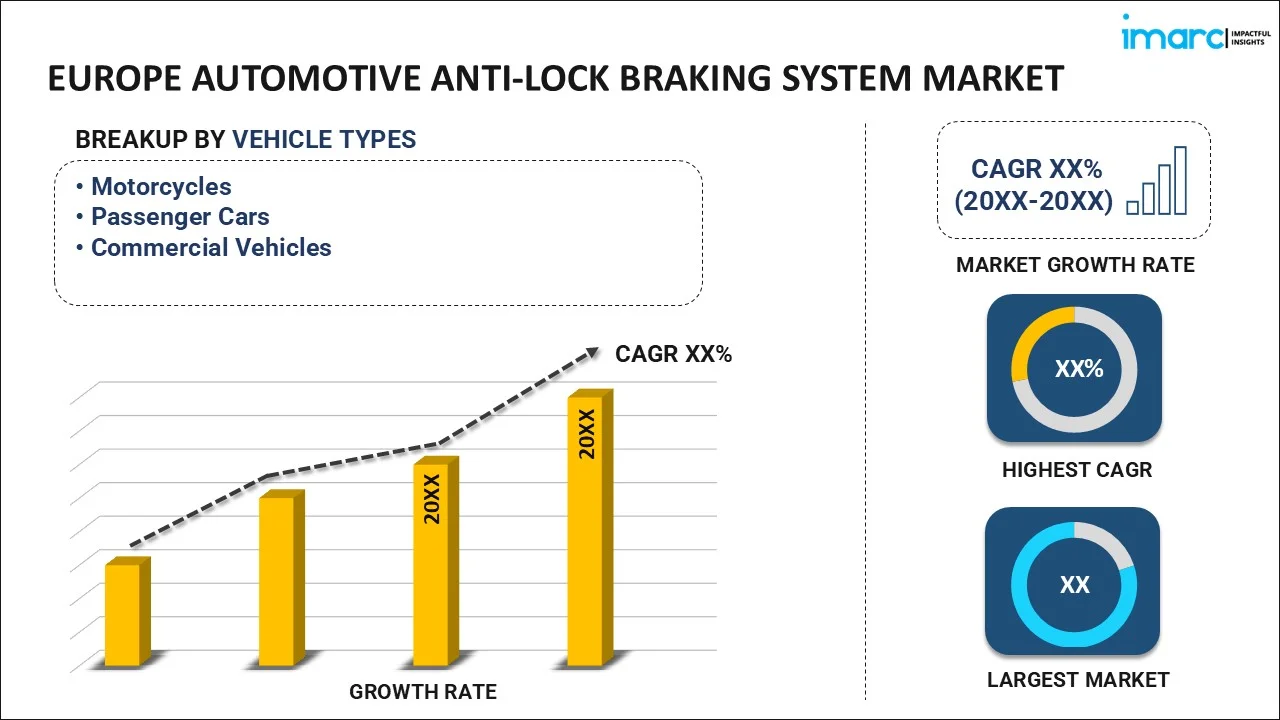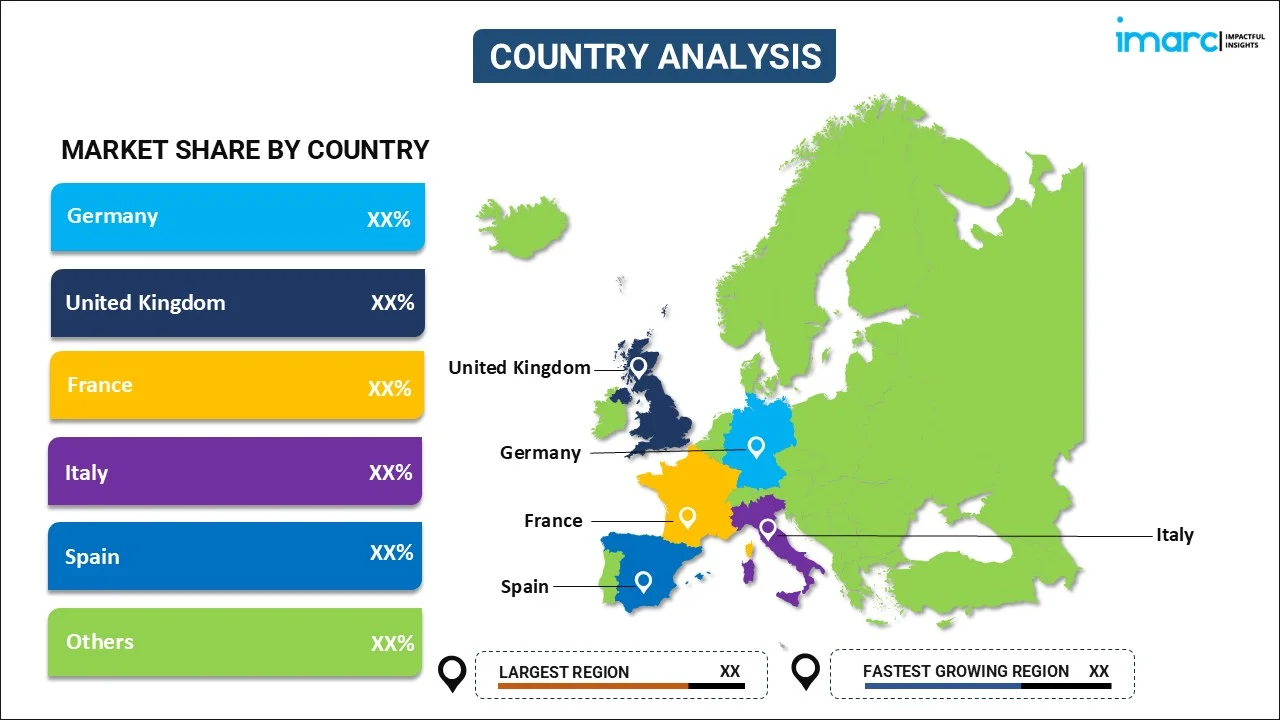
Europe Automotive Anti-Lock Braking System Market Size, Share, Trends, and Forecast by Vehicle Type, Technology, Sales Channel, and Country, 2025-2033
Europe Automotive Anti-Lock Braking System Market Overview:
The Europe automotive anti-lock braking system market size reached USD 12.71 Billion in 2024. Looking forward, IMARC Group expects the market to reach USD 23.77 Billion by 2033, exhibiting a growth rate (CAGR) of 7.20% during 2025-2033. The market is expanding due to stringent safety regulations, rising electric vehicle adoption, and technological advancements. Additionally, automakers focus on integrating ABS with stability control and AI-driven braking solutions, enhancing vehicle safety, efficiency, and regulatory compliance.
|
Report Attribute
|
Key Statistics
|
|---|---|
|
Base Year
|
2024 |
|
Forecast Years
|
2025-2033
|
|
Historical Years
|
2019-2024
|
| Market Size in 2024 | USD 12.71 Billion |
| Market Forecast in 2033 | USD 23.77 Billion |
| Market Growth Rate (2025-2033) | 7.20% |
Europe Automotive Anti-Lock Braking System Market Trends:
Stringent Safety Regulations Driving ABS Adoption
The European automotive industry is experiencing growing regulatory enforcement for vehicle safety, which is boosting demand for anti-lock braking systems (ABS) directly. The European Union requires ABS fitting on all new passenger and commercial cars to minimize skidding and stability improvement. Germany, France, and the UK have strengthened safety standards, pressuring automakers to incorporate sophisticated braking technologies. The EU General Safety Regulation (GSR) updates necessitate ongoing advancements in ABS performance, prompting manufacturers to create more effective and responsive braking systems. For instance, in July 2024, the EU imposed a law on all new cars to be equipped with advanced safety features. These include automatic braking, lane-keeping, speed assistance, driver alertness monitoring, and accident data recording to improve road safety and reduce traffic accidents. In addition, insurance discounts for ABS-equipped cars are driving adoption in different segments. Automakers are emphasizing compliance-led innovation, integrating ABS with electronic stability control (ESC) and traction control systems (TCS) for improved vehicle safety. As road safety awareness grows, the consumer demand for ABS-equipped models is increasing, especially in high-performance and luxury cars. These regulations combined with technological developments are transforming the European ABS market dynamics. With increasingly stringent regulatory systems, the need for advanced ABS solutions will further increase, ensuring advanced braking technology becomes a key feature in new European automobiles.
Rising Demand for Electric Vehicles (EVs) Boosting ABS Integration
The boom in electric vehicle (EV) uptake in Europe is fueling demand for advanced anti-lock braking systems (ABS) optimized for regenerative braking and traction control. For instance, according to industry reports, German electric car sales are projected to rise by 75% to 666,000 BEV sales in 2025. Moreover, EV makers are applying sophisticated ABS for improved vehicle stability and maximum energy recovery. For EVs, unlike ICE-driven vehicles, braking needs to be precise to tackle battery efficiency while avoiding skid caused by in-line torque distribution. Governments across Europe are supporting EV penetration using strict emission levels and economic stimulus, further adding to the penetration of ABS. Car manufacturers are creating lightweight as well as efficient ABS to cope with EV structural demands. Brake-by-wire technology, where hydraulic parts are substituted with electronic control, is finding increasing acceptance in EVs, improving braking accuracy and responsiveness. This trend is compelling ABS makers to develop innovative electronic and AI-driven braking systems. Furthermore, with the increasing sales of EVs, the need for ABS with sophisticated control algorithms and real-time monitoring will increase. The growing EV market is helping to define the future of ABS technology in Europe.
Europe Automotive Anti-Lock Braking System Market Segmentation:
IMARC Group provides an analysis of the key trends in each segment of the market, along with forecasts at the country level for 2025-2033. Our report has categorized the market based on vehicle type, technology, and sales channel.
Vehicle Type Insights:

- Motorcycles
- Passenger Cars
- Commercial Vehicles
The report has provided a detailed breakup and analysis of the market based on the vehicle type. This includes motorcycles, passenger cars, and commercial vehicles.
Technology Insights:
- Sensors
- Hydraulic Unit
- Electronic Control
A detailed breakup and analysis of the market based on the technology have also been provided in the report. This includes sensors, hydraulic unit, and electronic control.
Sales Channel Insights:
- OEM
- Aftermarket
A detailed breakup and analysis of the market based on the sales channel have also been provided in the report. This includes OEM and aftermarket.
Country Insights:

- Germany
- France
- United Kingdom
- Italy
- Spain
- Others
The report has also provided a comprehensive analysis of all the major regional markets, which include Germany, France, United Kingdom, Italy, Spain, and Others.
Competitive Landscape:
The market research report has also provided a comprehensive analysis of the competitive landscape. Competitive analysis such as market structure, key player positioning, top winning strategies, competitive dashboard, and company evaluation quadrant has been covered in the report. Also, detailed profiles of all major companies have been provided.
Europe Automotive Anti-Lock Braking System Market News:
- In November 2024, Bosch introduced ABSi, its latest anti-lock braking system. The system integrates an inertial measurement unit into the ABS, reducing wiring complexity.
Europe Automotive Anti-Lock Braking System Market Report Coverage:
| Report Features | Details |
|---|---|
| Base Year of the Analysis | 2024 |
| Historical Period | 2019-2024 |
| Forecast Period | 2025-2033 |
| Units | Billion USD |
| Scope of the Report | Exploration of Historical Trends and Market Outlook, Industry Catalysts and Challenges, Segment-Wise Historical and Future Market Assessment:
|
| Vehicle Types Covered | Motorcycles, Passenger Cars, Commercial Vehicles |
| Technologies Covered | Sensors, Hydraulic Unit, Electronic Control |
| Sales Channels Covered | OEM, Aftermarket |
| Countries Covered | Germany, France, United Kingdom, Italy, Spain, Others |
| Customization Scope | 10% Free Customization |
| Post-Sale Analyst Support | 10-12 Weeks |
| Delivery Format | PDF and Excel through Email (We can also provide the editable version of the report in PPT/Word format on special request) |
Key Questions Answered in This Report:
- How has the Europe automotive anti-lock braking system market performed so far and how will it perform in the coming years?
- What is the breakup of the Europe automotive anti-lock braking system market on the basis of vehicle type?
- What is the breakup of the Europe automotive anti-lock braking system market on the basis of technology?
- What is the breakup of the Europe automotive anti-lock braking system market on the basis of sales channel?
- What is the breakup of the Europe automotive anti-lock braking system market on the basis of country?
- What are the various stages in the value chain of the Europe automotive anti-lock braking system market?
- What are the key driving factors and challenges in the Europe automotive anti-lock braking system market?
- What is the structure of the Europe automotive anti-lock braking system market and who are the key players?
- What is the degree of competition in the Europe automotive anti-lock braking system market?
Key Benefits for Stakeholders:
- IMARC’s industry report offers a comprehensive quantitative analysis of various market segments, historical and current market trends, market forecasts, and dynamics of the Europe automotive anti-lock braking system market from 2019-2033.
- The research report provides the latest information on the market drivers, challenges, and opportunities in the Europe automotive anti-lock braking system market.
- Porter's five forces analysis assist stakeholders in assessing the impact of new entrants, competitive rivalry, supplier power, buyer power, and the threat of substitution. It helps stakeholders to analyze the level of competition within the Europe automotive anti-lock braking system industry and its attractiveness.
- Competitive landscape allows stakeholders to understand their competitive environment and provides an insight into the current positions of key players in the market.
Need more help?
- Speak to our experienced analysts for insights on the current market scenarios.
- Include additional segments and countries to customize the report as per your requirement.
- Gain an unparalleled competitive advantage in your domain by understanding how to utilize the report and positively impacting your operations and revenue.
- For further assistance, please connect with our analysts.
 Inquire Before Buying
Inquire Before Buying
 Speak to an Analyst
Speak to an Analyst
 Request Brochure
Request Brochure
 Request Customization
Request Customization




.webp)




.webp)












